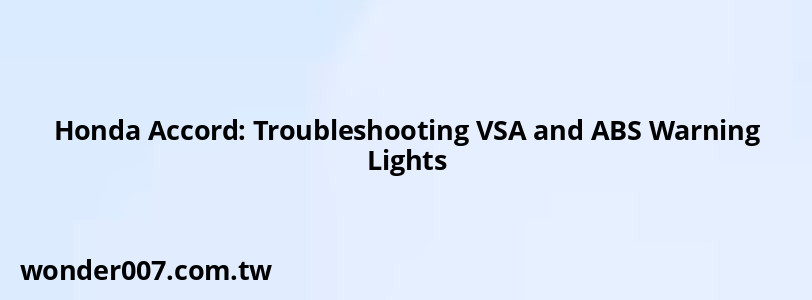Honda Accord: Troubleshooting VSA and ABS Warning Lights

When the VSA (Vehicle Stability Assist) and ABS (Anti-lock Braking System) lights illuminate on your Honda Accord's dashboard, it indicates a potential issue with the vehicle's braking or stability systems. This situation can be concerning for drivers, as it often signals that important safety features may be compromised. Understanding the causes and solutions is essential for maintaining vehicle safety and performance.
Understanding VSA and ABS Lights
The VSA light typically activates when there is a malfunction in the stability control system, while the ABS light indicates a problem with the anti-lock braking system. Both lights can illuminate simultaneously due to related issues, often involving wheel speed sensors, wiring problems, or faults in the ABS control module.
Common Causes:- Faulty Wheel Speed Sensors: These sensors monitor wheel rotation speed and can trigger warning lights if they fail.
- Wiring Issues: Damaged or corroded wiring can disrupt communication between components.
- ABS Control Module Failure: A malfunctioning module can disable both ABS and VSA functions.
- Tire Size Discrepancies: Unequal tire sizes can confuse the system and cause warning lights to activate.
Initial Troubleshooting Steps
If you notice the VSA and ABS lights on your dashboard, follow these initial troubleshooting steps:
1. Restart Your Vehicle: Sometimes, simply turning off the engine and restarting can reset the systems.
2. Inspect Tire Pressure: Ensure all tires are inflated to the recommended levels. Low tire pressure can trigger warning lights.
3. Check for Error Codes: Use an OBD-II scanner to read any diagnostic trouble codes (DTCs). This step can provide specific insights into what might be wrong.
Resetting VSA and ABS Lights
If there are no critical faults detected but the lights remain on, you may attempt to reset them using a specific procedure:
1. Locate the OBD-II Connector: Find the connector under the dashboard on the driver's side.
2. Jump Pins 4 and 9: Use a paper clip or jumper wire to connect these pins.
3. Turn Ignition On: With the brake pedal released, turn the ignition to "ON" (do not start the engine).
4. Follow Light Indicators:
- The ABS light should illuminate briefly before turning off.
- Release the brake pedal after it turns off, then press it again until the light goes off.
- Wait for two flashes of the ABS light to confirm a successful reset.
5. Reset VSA:
- Remove the jumper wire and ground pin 9.
- Turn ignition ON again without pressing the brake pedal.
- Press the VSA button once; observe for changes in light behavior.
Note: If warning lights persist after this procedure, further diagnostics may be necessary.When to Seek Professional Help
If basic troubleshooting does not resolve the issue, or if error codes indicate serious faults (such as sensor failures or module issues), it is advisable to consult a professional mechanic. They will have access to specialized diagnostic tools that can accurately identify complex issues within your vehicle’s systems.
FAQs About Honda Accord VSA and ABS Lights
- What does it mean if both lights are on?
This typically indicates a malfunction in your vehicle's braking or stability systems. - Can I drive my Honda Accord with these lights on?
While you may be able to drive, it's unsafe as ABS and VSA functions are disabled. - How much does it cost to fix these issues?
Costs vary widely based on diagnosis; simple sensor replacements may cost less than $100, while module replacements can exceed $1,000.
Related Posts
-
Chevy Cruze Defrost: Troubleshooting Common Issues
30-01-2025 • 216 views -
Dodge Ram Starts Then Shuts Off: Troubleshooting Guide
30-01-2025 • 207 views -
Ford Explorer: Troubleshooting Starting Issues with a Good Battery
29-01-2025 • 167 views -
2001 Honda Accord Power Steering Pump: Essential Guide for Owners
26-01-2025 • 163 views -
Headlights for 1996 Chevy Silverado: Upgrade Guide
26-01-2025 • 223 views
Latest Posts
-
Power Steering Fluid Leak On Passenger Side
01-02-2025 • 420 views -
How To Turn Off Paddle Shifters Mercedes
01-02-2025 • 335 views -
2015 Chevy Traverse AC Recharge Port Location
01-02-2025 • 366 views -
Rear Brake Caliper Piston Won't Compress
01-02-2025 • 315 views -
Are O2 Sensors Covered Under Warranty
01-02-2025 • 340 views
Popular Posts
-
EPC Warning Light: What It Means for Your Vehicle
27-01-2025 • 593 views -
EPC Light: Understanding Causes and Solutions
26-01-2025 • 1019 views -
Hino Warning Lights: Understanding Dashboard Alerts
26-01-2025 • 636 views -
V12 Engine Costs: What You Need to Know
26-01-2025 • 634 views -
Power Steering and ABS Light On: Causes and Solutions
27-01-2025 • 613 views
